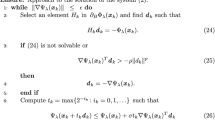Abstract
It has been shown previously that the Linear Complementarity Problem is stable when the defining matrix is positive semidefinite and when (locally) the set of solutions is nonempty and bounded. We enlarge the class of matrices for which this is true and also demonstrate how the boundedness condition leads to other stability type questions.
Similar content being viewed by others
References
M. Aganagic and R.W. Cottle, “A note onQ-matrices”,Mathematical Programming 16 (1979) 374–377.
R.W. Cottle, “Solution rays for a class of complementarity problems”,Mathematical Programming Study 1 (1974) 59–70.
B.C. Eaves, “The linear complementarity problem”,Management Science 17 (1971) 612–634.
C.B. Garcia, “Some classes of matrices in linear complementarity theory”,Mathematical Programming 5 (1974) 299–310.
S. Karamardian, “The complementarity problem”,Mathematical Programming 2 (1972) 107–129.
L.M. Kelly and L.T. Watson, “Erratum: Some perturbation theorems forQ-matrices”,SIAM Journal of Applied Mathematics 34 (1978) 320–321.
L.M. Kelly and L.T. Watson, “Q-matrices and spherical geometry”,Linear Algebra and Its Applications 25 (1979) 175–190.
C.E. Lemke and J.T. Howson Jr., “Equilibrium points of bimatrix games”,SIAM Journal of Applied Mathematics 12 (1964) 413–423.
C.E. Lemke, “Recent results in complementarity problems”, in: J.B. Rosen, O.L. Mangasarian and K. Ritter, eds.,Nonlinear programming (Academic Press, New York, 1970) pp. 349–384.
O.L. Mangasarian, “Characterization of bounded solutions of linear complementarity problems”, University Wisconsin Technical Report No. 359 (December 1979).
K.G. Murty, “On a characterization ofP-matrices”,SIAM Journal of Applied Mathematics 20 (1971) 378–384.
J.S. Pang, “OnQ-matrices”,Mathematical Programming 17 (1979) 243–247.
S.M. Robinson, “Generalized equations and their solutions, Part I: Basic theory”,Mathematical Programming Study 10 (1979) 128–146.
R. Saigal, “A characterization of the constant parity property of the number of solutions to the linear complementarity problem”,SIAM Journal of Applied Mathematics 23 (1972) 40–45.
R. Saigal, “On the class of complementary cones and Lemke's algorithm”,SIAM Journal of Applied Mathematics 23 (1972) 46–60.
A. Tamir, “The complementarity problem of mathematical programming”, Ph.D. dissertation, Case Western Reserve University (Cleveland, OH, 1973).
L.T. Watson, “A variational approach to the linear complementarity problem”, Ph.D. dissertation, Department of Mathematics, University of Michigan (Ann Arbor, MI, 1974).
L.T. Watson, “Some perturbation theorems forQ-matrices”,SIAM Journal of Applied Mathematics 31 (1976) 379–384.
L.T. Watson, “An algorithm for the linear complementarity problem”,International Journal for Computer Mathematics 6 (1978) 319–325.
Author information
Authors and Affiliations
Rights and permissions
About this article
Cite this article
Doverspike, R.D. Some perturbation results for the Linear Complementarity Problem. Mathematical Programming 23, 181–192 (1982). https://doi.org/10.1007/BF01583787
Received:
Revised:
Issue Date:
DOI: https://doi.org/10.1007/BF01583787



